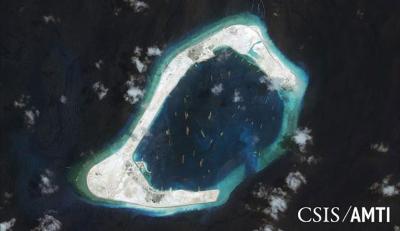
China Reacts to US Ships in South China Seas

Tuesday Oct 27: China reacted more harshly than expected to the passage last week of the warship USS Lassen that skirted within 12 miles of one of Beijing’s newly-created and increasingly militarized South China Sea islands.
Chinese foreign ministry summoned US ambassador over the incident and lodged a strong protest.
Addressing journalists in Beijing on Tuesday, Oct 27, afternoon, Lu Kang, a foreign ministry spokesman, said China was strongly dissatisfied with America’s actions, which he described as a threat to China’s sovereignty.
But he refused to be drawn on whether China would consider a military response. “I will not answer hypothetical questions,” Lu said. “We hope that the US side will not take actions that will backfire.”
Lu warned that further “provocative actions” might lead to accelerated Chinese construction in the South China Sea: “It would be a pity for us to realise that we have to strengthen and speed up relevant construction activities.”
The Chinese embassy in Washington said the concept of “freedom of navigation” should not be used as an excuse for muscle-flexing and the US should “refrain from saying or doing anything provocative and act responsibly in maintaining regional peace and stability”.
China claims most of the South China Sea on the basis of a segmented line that first appeared on Chinese maps in the 1940s. More than $5 trillion of world trade transits every year through the South China Seas. Vietnam, Malaysia, Brunei, the Philippines and Taiwan all have rival claims.
US Counters by planning more patrols

BEIJING Nov 03: “International seas and airspace belong to everyone and are not the dominion of any single nation,” admiral Harry Harris said, according to prepared remarks for a speech at the Stanford Center at Peking University while dismissing China’s claim as “ambiguous” and based on “the so-called 9-dash line”.
“Our military will continue to fly, sail, and operate whenever and wherever international law allows. The South China Sea is not — and will not — be an exception,” he added.
Harris is the commander of the US Pacific Command and his public declaration in the Chinese capital is a mark of US resolve over the strategically vital waterway, where Beijing has built up rocks and reefs into artificial islands with facilities for military use.
The US Navy plans to conduct patrols within 12 nautical miles of artificial islands in the South China Sea about twice a quarter to remind China and other countries about US rights under international law, a US defence official said on Monday.
The US military will continue to operate “wherever” international law allows, a top US admiral said in Beijing on Tuesday, a week after America infuriated China by sailing close to artificial islands it is building in the South China Sea.
US Vice Admiral John Aquilino, deputy chief of naval operations for operations, plans and strategies, declined to comment about when the next patrols would take place.
“We do operations like that all the time around the world. That will continue for us,” he told Reuters after his remarks at the same conference. “We’ll just keep going.”
US Defense Secretary Ash Carter takes a swipe at China

ABOARD THE USS THEODORE ROOSEVELT (AP) — In a symbolic swipe at China’s muscular moves in the South China Sea, U.S. Defense Secretary Ash Carter visited an American aircraft carrier in the disputed waterway.
Carter, who was in Malaysia for two days of talks with Asian defense ministers, used the visit to the USS Theodore Roosevelt to amplify the U.S. view that China is making excessive claims that nearly all of the South China Sea as its territory.
Carter also signaled that the U.S. will keep a strong naval presence in the region in support of nations seeking to preserve stability. He flew aboard the carrier in a V-22 Osprey from a base in the east Malaysian state of Sabah, which is situated on the northern portion of Borneo.
In announcing his visit Wednesday, Carter called it a “symbol of our commitment” to focusing more on U.S. interests in the Asia-Pacific following more than a decade of wars in the Middle East.
Malaysian Defense Minister Hishammuddin Hussein accompanied Carter to the carrier, highlighting U.S. efforts to strengthen defense partnerships in the Asia-Pacific. Malaysia is among several countries that claim a portion of the South China Sea and disagree with China’s building of artificial islands.
The Pentagon also is interested in making arrangements with Malaysia for more regular access to the naval base at Sabah for U.S. aircraft carriers.





Be the first to comment